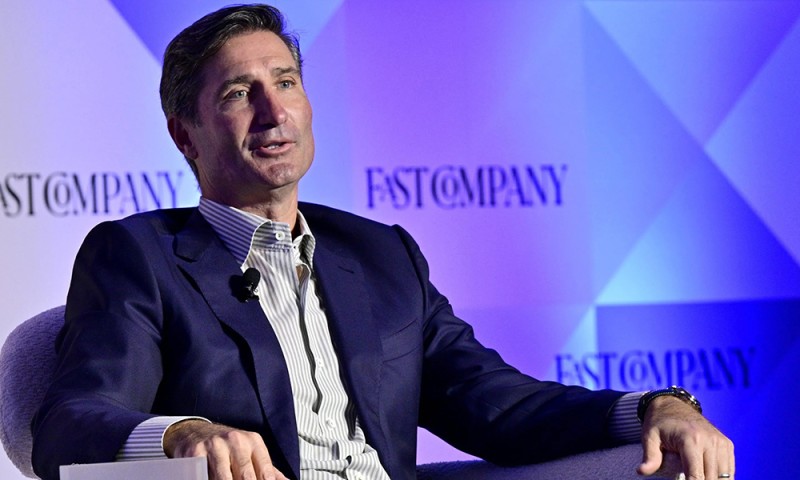
星巴克(Starbucks)首席执行官布莱恩·尼科尔证实,这家咖啡巨头正在深入开展人工智能试验。他透露,公司内部已开发出可实时协助员工工作的系统,并暗示未来星巴克App或将具备“先于顾客下单”就能预测点单的能力。
在旧金山举行的赛富时(Salesforce)年度技术盛会Dreamforce上,尼科尔强调,尽管星巴克目前在AI领域仍处于学习和试验阶段,但该技术已经开始助力公司实现再次成为“全球最佳客户服务企业”的目标。
目前,星巴克内部规模化应用中最具影响力的AI创新,是一款名为“绿点助手”的工具,可充当“咖啡师助手”。这套内部系统在门店的日常运营管理中发挥着重要作用。如果员工遇到设备问题,或需要了解“某种饮品的制作方法”,绿点助手会利用AI技术快速提供准确答案或解决方案。星巴克方面向《财富》杂志透露,绿点助手自今年6月启动试点以来,已在公司内部逐步推广应用。
尽管人工智能技术取得显著进展,尼科尔仍迅速否认了配备“全机器人员工”的设想。他表示“我们目前还远未达到那种程度”,并强调星巴克一直致力于让“更多伙伴回归门店,用‘手艺和匠心’为顾客提供真实、有温度的体验,而非机械冰冷的服务”。AI的作用并非取代人类,而是用来释放生产力,帮助员工更快速、更高效地完成各项任务。
后台算法的威力
AI能够实时辅助咖啡师制作饮品、减少服务摩擦,其核心在于一项名为Smart Q的后台技术。该系统解决了此前四个不同点单渠道(汽车餐厅、外卖配送、移动端下单自提、柜台点单)给门店造成的运营“混乱”。尼科尔表示,他刚到星巴克任职时就发现,订单处理“完全遵循先来先出的原则,造成了诸多瓶颈”,而这正是他努力改进的重点。
Smart Q通过在最优时段优先处理适当的订单来疏通瓶颈。该系统的目标是提高速度与准确性:确保堂食或汽车餐厅顾客可在四分钟内拿到饮品,并确保移动端订单准时交付。顾客还可以通过数字显示屏看到订单状态,从“已接单”、“制作中”到“已完成”,实时追踪订单进度。
预测未来,实现无摩擦点单
展望未来,尼科尔表示,星巴克App将成为AI深度融合的重点领域,尤其是在预测顾客点单方面。目前,该应用已具备便捷功能,允许用户一键复购最近一次的订单。但在他看来,该功能仍有切实改进的空间,可让点单过程“更快捷、更顺畅”。
尼科尔表示,按照他的设想,未来星巴克将为顾客提供几乎没有摩擦的体验,AI驱动系统可能实现深度无缝整合,顾客甚至无需打开应用。他举例称,顾客只需对着手机说:“嗨,我要买一杯星巴克,10分钟后到店取”,饮品就会在其到达时准备就绪。这种更准确地“预判顾客消费意向的能力”,以及语音下单功能,正是星巴克计划利用AI提升个性化服务与效率的方向。
这些AI举措是尼科尔上任CEO一年多来推动战略转型的重要组成部分。星巴克正将战略重心从效率与任务导向,转向重新聚焦于提供卓越的客户服务体验,确保咖啡师能获得充足的资源和支持,为顾客制作更具个性化的饮品。例如,7月,尼科尔叫停了强调“减少人际互动、增加移动端下单自提点”的策略,转而回归由传奇CEO霍华德·舒尔茨所倡导的“第三空间”理念,让门店再次成为人们放松、社交与交流的场所。到了10月,尼科尔进一步加码,以10亿美元重组计划全面推动这一战略落地。
与此同时,星巴克向《财富》杂志强调,公司正努力简化菜单,聚焦“更少但更受欢迎的精品,并力求完美呈现”。此举旨在释放创新空间,有助于缩短顾客等候时间,并提升产品质量与一致性。7月,公司启动名为“Starting 5”的项目,在新产品与创新方案全国推广前由五家咖啡店先行试点,以确保创新具有可持续性并达到高质量标准。
尼科尔在Dreamforce大会上表示,星巴克还在其他业务环节探索AI的应用,包括视觉识别、库存管理、供应链管理、需求预测与排班系统等。不过,这些应用目前尚未实现大规模推广。尼科尔相信,AI的出现无疑是提升效率的重要契机,并表示AI已经在技术领域产生“重大影响”,例如大幅提升了代码生成速度。(*)
《财富》杂志使用生成式AI辅助完成本文的初稿。编辑在发表前已核实信息的准确性。
译者:刘进龙
审校:汪皓
星巴克(Starbucks)首席执行官布莱恩·尼科尔证实,这家咖啡巨头正在深入开展人工智能试验。他透露,公司内部已开发出可实时协助员工工作的系统,并暗示未来星巴克App或将具备“先于顾客下单”就能预测点单的能力。
在旧金山举行的赛富时(Salesforce)年度技术盛会Dreamforce上,尼科尔强调,尽管星巴克目前在AI领域仍处于学习和试验阶段,但该技术已经开始助力公司实现再次成为“全球最佳客户服务企业”的目标。
目前,星巴克内部规模化应用中最具影响力的AI创新,是一款名为“绿点助手”的工具,可充当“咖啡师助手”。这套内部系统在门店的日常运营管理中发挥着重要作用。如果员工遇到设备问题,或需要了解“某种饮品的制作方法”,绿点助手会利用AI技术快速提供准确答案或解决方案。星巴克方面向《财富》杂志透露,绿点助手自今年6月启动试点以来,已在公司内部逐步推广应用。
尽管人工智能技术取得显著进展,尼科尔仍迅速否认了配备“全机器人员工”的设想。他表示“我们目前还远未达到那种程度”,并强调星巴克一直致力于让“更多伙伴回归门店,用‘手艺和匠心’为顾客提供真实、有温度的体验,而非机械冰冷的服务”。AI的作用并非取代人类,而是用来释放生产力,帮助员工更快速、更高效地完成各项任务。
后台算法的威力
AI能够实时辅助咖啡师制作饮品、减少服务摩擦,其核心在于一项名为Smart Q的后台技术。该系统解决了此前四个不同点单渠道(汽车餐厅、外卖配送、移动端下单自提、柜台点单)给门店造成的运营“混乱”。尼科尔表示,他刚到星巴克任职时就发现,订单处理“完全遵循先来先出的原则,造成了诸多瓶颈”,而这正是他努力改进的重点。
Smart Q通过在最优时段优先处理适当的订单来疏通瓶颈。该系统的目标是提高速度与准确性:确保堂食或汽车餐厅顾客可在四分钟内拿到饮品,并确保移动端订单准时交付。顾客还可以通过数字显示屏看到订单状态,从“已接单”、“制作中”到“已完成”,实时追踪订单进度。
预测未来,实现无摩擦点单
展望未来,尼科尔表示,星巴克App将成为AI深度融合的重点领域,尤其是在预测顾客点单方面。目前,该应用已具备便捷功能,允许用户一键复购最近一次的订单。但在他看来,该功能仍有切实改进的空间,可让点单过程“更快捷、更顺畅”。
尼科尔表示,按照他的设想,未来星巴克将为顾客提供几乎没有摩擦的体验,AI驱动系统可能实现深度无缝整合,顾客甚至无需打开应用。他举例称,顾客只需对着手机说:“嗨,我要买一杯星巴克,10分钟后到店取”,饮品就会在其到达时准备就绪。这种更准确地“预判顾客消费意向的能力”,以及语音下单功能,正是星巴克计划利用AI提升个性化服务与效率的方向。
这些AI举措是尼科尔上任CEO一年多来推动战略转型的重要组成部分。星巴克正将战略重心从效率与任务导向,转向重新聚焦于提供卓越的客户服务体验,确保咖啡师能获得充足的资源和支持,为顾客制作更具个性化的饮品。例如,7月,尼科尔叫停了强调“减少人际互动、增加移动端下单自提点”的策略,转而回归由传奇CEO霍华德·舒尔茨所倡导的“第三空间”理念,让门店再次成为人们放松、社交与交流的场所。到了10月,尼科尔进一步加码,以10亿美元重组计划全面推动这一战略落地。
与此同时,星巴克向《财富》杂志强调,公司正努力简化菜单,聚焦“更少但更受欢迎的精品,并力求完美呈现”。此举旨在释放创新空间,有助于缩短顾客等候时间,并提升产品质量与一致性。7月,公司启动名为“Starting 5”的项目,在新产品与创新方案全国推广前由五家咖啡店先行试点,以确保创新具有可持续性并达到高质量标准。
尼科尔在Dreamforce大会上表示,星巴克还在其他业务环节探索AI的应用,包括视觉识别、库存管理、供应链管理、需求预测与排班系统等。不过,这些应用目前尚未实现大规模推广。尼科尔相信,AI的出现无疑是提升效率的重要契机,并表示AI已经在技术领域产生“重大影响”,例如大幅提升了代码生成速度。(*)
《财富》杂志使用生成式AI辅助完成本文的初稿。编辑在发表前已核实信息的准确性。
译者:刘进龙
审校:汪皓
Starbucks CEO Brian Niccol confirmed the coffee giant is deeply immersed in artificial intelligence (AI) experimentation, revealing details about internal systems designed to assist staff in real time and pointing toward a future where the Starbucks app may soon anticipate customer orders before they are even placed.
Speaking at Dreamforce, Salesforce’s annual technology gathering in San Francisco, Niccol emphasized that while Starbucks is currently focused on learning and experimentation within the AI space, the technology is already helping the company execute its goal of becoming the “world’s greatest customer service company again.”
The most impactful AI development currently at scale within the company is a tool known as the “green dot,” which acts as a “kind of barista assistant.” This internal system is crucial for helping store leaders manage daily operations. If a partner encounters a problem with equipment or needs guidance on “how to build a certain drink,” the green dot uses AI to quickly deliver the right answer or solution. A representative for Starbucks told Fortune that green dot was piloted beginning in June and has been rolling out more widely since then.
Despite the advancements in artificial intelligence, Niccol was quick to squash any notions of a fully robotic staff, saying “we’re not near that right now” and emphasizing that Starbucks has been focused on putting “more partners back into our stores to give people a great, not robotic” experience rooted in “real craft.” Instead, AI is being leveraged to unleash productivity and help human employees accomplish tasks more quickly and efficiently.
Behind-the-scenes sequencing
A key component of how AI assists baristas with making coffee in real time and reducing service friction is a behind-the-scenes technology called “smart Q.” This system addresses the operational “chaos” that previously existed when orders—which can come from four different access modes: drive-thru, delivery, mobile order pickup, and the counter. When he arrived at Starbucks, Niccol said he found that orders were “all first in first, out—it created a lot of bottlenecks,” and that’s what he’s been working hard to remedy.
Smart Q works to smooth out these bottlenecks by prioritizing the correct order at the optimal time. The goal is speed and accuracy: to ensure that drinks are delivered in under four minutes for in-cafe or drive-thru customers, and on time for mobile orders. Customers may also see evidence of this system via digital screens that display the order status as “received,” “in progress,” or “ready,” which helps customers track their drink’s progress.
Predicting the future and frictionless ordering
Looking ahead, Niccol identified the Starbucks app as a major focus for future AI integration, particularly in terms of predicting customer orders. Currently, the app offers a seamless feature allowing users to select their most recent order. However, the CEO sees a real opportunity to iterate on this feature, making the ordering process “even faster [and] even more seamless.”
Niccol said he envisions a future where friction is entirely removed from the experience, potentially integrating AI-driven systems so seamlessly that customers might not even need to open the app. He suggested that a user could simply talk into their phone, saying, “Hey I need my Starbucks order I’ll be there in 10 minutes,” and the drink would be ready upon arrival. This ability to be more “anticipating what we know you’re going to order,” along with the implementation of voice ordering, is where the brand plans to utilize AI to enhance personalization and speed.
These AI initiatives are part of the larger strategic shift under Niccol, who took the CEO role over a year ago. The company is shifting its primary focus from efficiency and tasks to a renewed emphasis on delivering an exceptional customer service experience, ensuring that baristas are well-equipped to deliver personalized drinks. For instance, in July Niccol called time on a strategy emphasizing less personal interaction and more mobile-only pickup locations, pivoting toward a return to the “third space” made famous under legendary Starbucks CEO Howard Schultz. Niccol doubled down on the strategy with a $1 billion restructuring plan in October.
At the same time, Starbucks stressed to Fortune that the company is working to simplify its menu, focusing on “fewer, more popular items, executed with excellence.” This should allow space for innovation, help reduce wait times, and improve quality and consistency. In July, the company introduced the “Starting 5” program, in which five coffeehouses test innovations before they are rolled out nationally, ensuring that innovations are sustainable and of high quality.
Starbucks is also experimenting with AI across other facets of the business, Niccol said at Dreamforce, including vision, inventory, supply chain management, forecasting, and scheduling. However, these applications are not yet fully implemented at scale. Niccol said he believes AI is a definite opportunity to enhance efficiency, stating that they are already seeing a “big impact” in technology areas, such as the ability to generate code much faster.
For this story, Fortune used generative AI to help with an initial draft. An editor verified the accuracy of the information before publishing.

